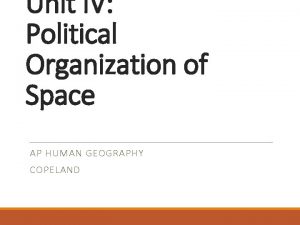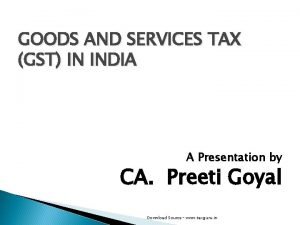Resolving international tax disputes in the context of









- Slides: 9

Resolving international tax disputes in the context of the OBOR initiative Qunfang Jiang 14 Sep 2017 University of Oxford

1. Background Information International double taxation Ø Taxation in host country (source country) Ø Taxation in home country (residence country) When international double taxation occurs, a company doing business abroad bears a heavier tax burden than a purely domestic company. Ways to eliminating International double taxation Ø Through bilateral tax treaties Ø Domestic law measures The public international law of taxation is dominated by over 3000 bilateral treaties. They represent the international cooperation on tax matters. By eliminating double taxation, tax treaties play an important role in promoting cross -border investments. 2

1. Background information (continued) OBOR, Tax Treaties and Tax disputes Ø OBOR initiative involves more than 70 countries and jurisdictions, and China has signed tax treaties with more than 50 of them. Ø As the OBOR significantly increases the volume of cross-border transactions, we can expect that tax disputes will also increase substantially. Ø Most of the international tax disputes relate to international double taxation. When such a tax dispute generates, either in the host country or in the home country, taxpayers usually resort to the remedies available in the domestic laws of that country. However, there are some disputes that cannot be solved unilaterally and thus call for a dispute resolution mechanism that can bring together the host country and the home country. 3

2. International dispute resolution mechanisms Two mechanisms are used by countries: Ø Mutual Agreement Procedure (MAP) Ø Mandatory Binding Arbitration 4

2. International dispute resolution mechanisms (continued) MAP: Ø The traditional and most widely-adopted approach to resolving international tax disputes Ø Requires countries to make efforts to resolve disputes on a mutually-agreed basis. Ø Three major weaknesses of MAP: a. MAP does not require countries to resolve disputes but only to use their best efforts to do so. b. MAP does not have detailed guidance and implementation procedures. c. Although taxpayers can present their cases to tax authorities, they are not allowed to participate directly in the consultation process. As a result, some disputes may remain unresolved for long periods or never be resolved when it is not possible to reach an agreement. 5

2. International dispute resolution mechanisms (continued) Mandatory binding arbitration: Ø Only allowed in certain tax treaties and served as a supplementary mechanism to the MAP mechanism. Supplementary mechanism: When a taxpayer’s dispute cannot be resolved through the mutual agreement procedure, the taxpayer can present the case to appointed arbitrators. Ø Characteristics of MAP: a. appointed arbitrators b. decide cases impartially and independently c. arbitration decisions are binding. Mandatory binding arbitration makes up the weaknesses of the MAP mechanism, and can help resolve international tax disputes more effectively. The business community, as well as a number of countries particularly welcome the arbitration procedure. 6

3. China’s position Current position: Ø Fully relies on the MAP mechanism, and does not show special interests for arbitration. Ø Possible reasons for this position: a. The most important one is that many countries including China fear that they might lose tax sovereignty and control over the outcome of tax disputes if they accept mandatory binding arbitration. b. lack of experiences and expertise in international tax arbitration 7

3. China’s position The need for changes in the context of OBOR initiative? Ø Corresponding to the OBOR initiative, resolving international tax disputes is high on the agenda of China’s tax authority. (See Announcement No. 56 [2013] of the State Administration of Taxation and Shui Zong Fa [2017] No. 42) Ø In the two official documents, the tax authority of China stresses the importance of improving the efficiency and effectiveness of MAP but does not consider any alternative mechanisms to resolve tax disputes. Ø As the OBOR initiative shows China’s ambition to promote globalization and enhance economic ties with more one-third of countries in the world, perhaps some changes should be made to the legal infrastructure, and in this case, the dispute resolution mechanisms on international tax matters. 8

Thank you for your attention! 9
 Prorupted state ap human geography
Prorupted state ap human geography Positional/definitional boundary disputes
Positional/definitional boundary disputes Superimposed boundary
Superimposed boundary Why might fishing disputes arise in the region?
Why might fishing disputes arise in the region? Chapter 4 settling disputes
Chapter 4 settling disputes Anatomy of industrial disputes
Anatomy of industrial disputes Consumer disputes redressal agencies
Consumer disputes redressal agencies Consumer disputes redressal agencies
Consumer disputes redressal agencies Change order disputes
Change order disputes Gst conclusion
Gst conclusion

















